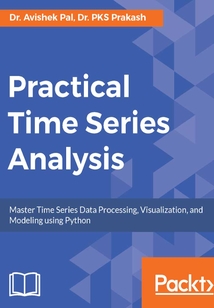目錄(106章)
倒序
- coverpage
- Title Page
- Copyright
- Practical Time Series Analysis
- Credits
- About the Authors
- About the Reviewer
- www.PacktPub.com
- Why subscribe?
- Customer Feedback
- Preface
- What this book covers
- What you need for this book
- Who this book is for
- Conventions
- Reader feedback
- Customer support
- Downloading the example code
- Errata
- Piracy
- Questions
- Introduction to Time Series
- Different types of data
- Cross-sectional data
- Time series data
- Panel data
- Internal structures of time series
- General trend
- Seasonality
- Run sequence plot
- Seasonal sub series plot
- Multiple box plots
- Cyclical changes
- Unexpected variations
- Models for time series analysis
- Zero mean models
- Random walk
- Trend models
- Seasonality models
- Autocorrelation and Partial autocorrelation
- Summary
- Understanding Time Series Data
- Advanced processing and visualization of time series data
- Resampling time series data
- Group wise aggregation
- Moving statistics
- Stationary processes
- Differencing
- First-order differencing
- Second-order differencing
- Seasonal differencing
- Augmented Dickey-Fuller test
- Time series decomposition
- Moving averages
- Moving averages and their smoothing effect
- Seasonal adjustment using moving average
- Weighted moving average
- Time series decomposition using moving averages
- Time series decomposition using statsmodels.tsa
- Summary
- Exponential Smoothing based Methods
- Introduction to time series smoothing
- First order exponential smoothing
- Second order exponential smoothing
- Modeling higher-order exponential smoothing
- Summary
- Auto-Regressive Models
- Auto-regressive models
- Moving average models
- Building datasets with ARMA
- ARIMA
- Confidence interval
- Summary
- Deep Learning for Time Series Forecasting
- Multi-layer perceptrons
- Training MLPs
- MLPs for time series forecasting
- Recurrent neural networks
- Bi-directional recurrent neural networks
- Deep recurrent neural networks
- Training recurrent neural networks
- Solving the long-range dependency problem
- Long Short Term Memory
- Gated Recurrent Units
- Which one to use - LSTM or GRU?
- Recurrent neural networks for time series forecasting
- Convolutional neural networks
- 2D convolutions
- 1D convolution
- 1D convolution for time series forecasting
- Summary
- Getting Started with Python
- Installation
- Python installers
- Running the examples
- Basic data types
- List tuple and set
- Strings
- Maps
- Keywords and functions
- Iterators iterables and generators
- Iterators
- Iterables
- Generators
- Classes and objects
- Summary 更新時間:2021-07-08 10:18:47
推薦閱讀
- JBoss Weld CDI for Java Platform
- Python程序設計教程(第2版)
- GAE編程指南
- HTML5移動Web開發技術
- Python Geospatial Development(Second Edition)
- 機械工程師Python編程:入門、實戰與進階
- Learning Python Design Patterns
- Learning AngularJS for .NET Developers
- Node Cookbook(Second Edition)
- MINECRAFT編程:使用Python語言玩轉我的世界
- 并行編程方法與優化實踐
- 深入實踐DDD:以DSL驅動復雜軟件開發
- SEO教程:搜索引擎優化入門與進階(第3版)
- Mastering Python
- Python程序設計
- 匯編語言程序設計教程
- Jenkins 2.x Continuous Integration Cookbook(Third Edition)
- C語言程序設計
- Learning Puppet Security
- Learning AirWatch
- Python密碼學編程(第2版)
- 數字圖像處理原理與實踐:基于Visual C++開發
- Mastering Numerical Computing with NumPy
- Kotlin Blueprints
- Sass Essentials
- 自動化運維軟件設計實戰
- Android移動開發項目式教程(第2版)
- Voice User Interface Projects
- Building Minecraft Server Modifications(Second Edition)
- Python編程基礎(中學版)


